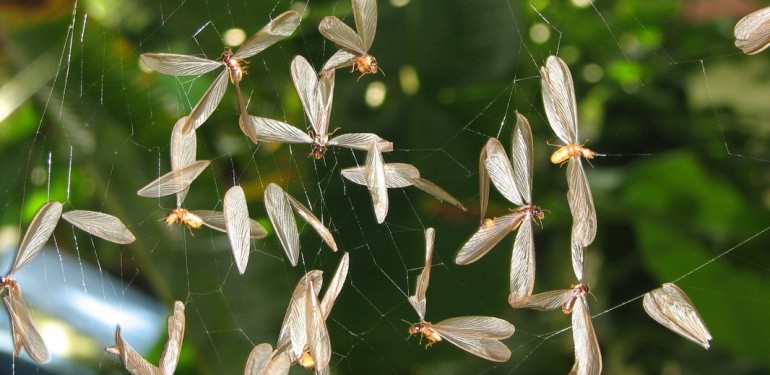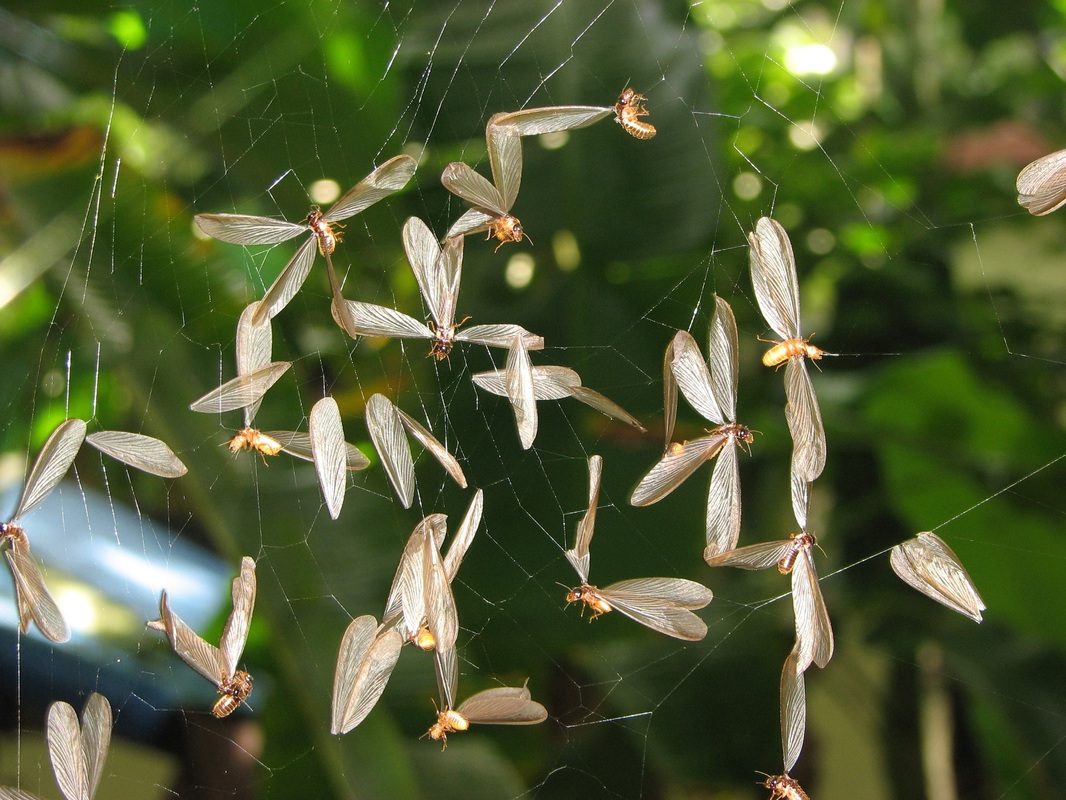
A sign that a termite nest may be located near you
What is an alate?
The life cycle of a termite is egg, nymph and adult stages. The termite nymph hatches directly from an egg. Attendants feed nymphs regurgitated food for the first two weeks, enabling them through moulting to become workers, soldiers, reproductive, or supplementary reproductive. It is at the transformation from the nymph to adult stage that a termite may become a soldier, worker or reproductive. These specialised groups are called castes. Each caste is physically different and performs a particular function. As the reproductive nymph matures, its body lengthens and sexual organs develop. The body turns black, eyes become functional, and wings extend twice its body length.
<span “font-size:11.0pt;font-family:”calibri”,sans-serif;mso-ascii-theme-font:=”” minor-latin;mso-fareast-font-family:calibri;mso-fareast-theme-font:minor-latin;=”” mso-hansi-theme-font:minor-latin;mso-bidi-font-family:”times=”” roman”;=”” mso-bidi-theme-font:minor-bidi;mso-ansi-language:en-au;mso-fareast-language:=”” en-us;mso-bidi-language:ar-sa”=””>Winged reproductives or alates are the future kings and queens of new nests. They have a well-developed cuticle, compound eyes, and two pairs of usually dark brown elongated membranous wings of equal length. Alates disperse in large numbers from mature colonies, usually in warm humid weather.
|
The alate flight starts when they emerge from a purpose built slit in the mud nest or through slits made in either wood or bark. These slits are often referred to as flight cuts and soldier termites generally congregate around the opening to prevent entry to the nest by natural enemies of termites. Generally in Perth termite nests will be located in underground, in tree stumps, or even in mounds located in tree branches. Specialist knowledge will be required to locate these nests. Above ground mounds have rare incidence in Perth. |
|
Where are alates found?
<span “font-size:11.0pt;font-family:”calibri”,sans-serif;mso-ascii-theme-font:=”” minor-latin;mso-fareast-font-family:calibri;mso-fareast-theme-font:minor-latin;=”” mso-hansi-theme-font:minor-latin;mso-bidi-font-family:”times=”” roman”;=”” mso-bidi-theme-font:minor-bidi;mso-ansi-language:en-au;mso-fareast-language:=”” en-us;mso-bidi-language:ar-sa”=””>In Perth, alate flights usually occur in either the November-December or March-April time periods which avoid the outright summer heat. The best conditions for alate flights are generally before or after a storm when there are moderate temperatures and high humidity.
<span “font-size:11.0pt;font-family:”calibri”,sans-serif;mso-ascii-theme-font:=”” minor-latin;mso-fareast-font-family:calibri;mso-fareast-theme-font:minor-latin;=”” mso-hansi-theme-font:minor-latin;mso-bidi-font-family:”times=”” roman”;=”” mso-bidi-theme-font:minor-bidi;mso-ansi-language:en-au;mso-fareast-language:=”” en-us;mso-bidi-language:ar-sa”=””>Alates are known to be weak fliers and their wings are often found within spider webs or other areas around the home. The wings will be equal size, differing to that of flying ants.<span “font-size:11.0pt;font-family:”calibri”,sans-serif;mso-ascii-theme-font:=”” minor-latin;mso-fareast-font-family:calibri;mso-fareast-theme-font:minor-latin;=”” mso-hansi-theme-font:minor-latin;mso-bidi-font-family:”times=”” roman”;=”” mso-bidi-theme-font:minor-bidi;mso-ansi-language:en-au;mso-fareast-language:=”” en-us;mso-bidi-language:ar-sa”=””>
What should I do if I find alates at my home?
Most alates that leave a nest will not form a new termite colony. Alates most often will become the prey of birds, lizards, dragonflies etc., and you will often see them attracted to a light source. If they do not find a mate and suitable environment, they will die off without ever onwardly breeding and this is generally the fate of the vast majority of the alates.
A pair of de-alates, which is a description of alates that have dropped their wings, will then proceed to start a nest generally in soil or decayed wood. The termite pairing will then excavate a chamber for the purposes of breeding and the queen will subsequently lay a small number of eggs. It usually takes years for a newly-formed termite nest to have the capacity to cause significant structural damage to a home.
<span “font-size:11.0pt;font-family:”calibri”,sans-serif;mso-ascii-theme-font:=”” minor-latin;mso-fareast-font-family:calibri;mso-fareast-theme-font:minor-latin;=”” mso-hansi-theme-font:minor-latin;mso-bidi-font-family:”times=”” roman”;=”” mso-bidi-theme-font:minor-bidi;mso-ansi-language:en-au;mso-fareast-language:=”” en-us;mso-bidi-language:ar-sa”=””>However, if alates are found then there is a high probability that an established termite nest is in close proximity to your property. This is due to the poor flying capacity of alates. Regular inspections of your property should therefore be carried out, and consideration should be taken as to a perimeter treatment being carried out. You should also inform your neighbours as to your discovery, as the termite nest may be located at their property, or even damaging their home.

